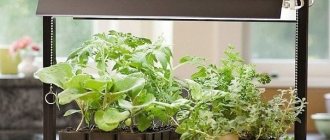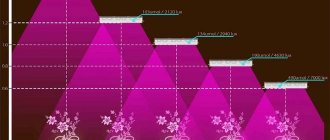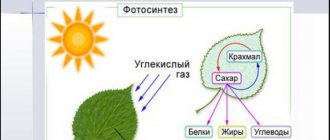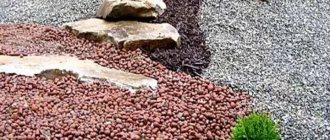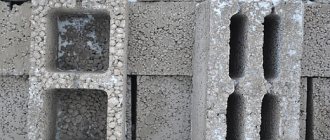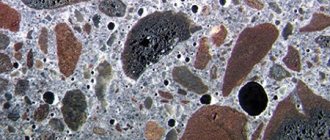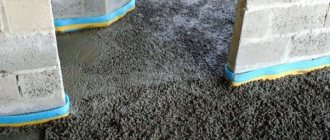Production and properties of expanded clay
To make expanded clay, clay shales or clays of a certain composition are used. The starting material should contain about 30% quartz, 10% ferrous and 1% organic impurities. The raw material mass is pre-processed to obtain granules of a certain size. Then they are poured into a rotating kiln in the form of a drum located at a slight angle. Under the influence of high temperature (about 1200 ° C), the clay boils and swells, and its outer layer melts. Then the granules are cooled in several stages. As a result of this processing, it acquires a characteristic finely porous structure with a hard shell. Depending on the features of the technology, the density of the material and the grain size vary: from 250 kg/m 3 to 800 kg/m 3 and from 5 to 40 mm.
Expanded clay has a number of useful properties for practical use. Its excellent thermal insulation and strength characteristics are widely known. In addition, the material is durable, frost-resistant, resistant to fungi, mold and chemically active substances. It is non-flammable, environmentally friendly and does not affect soil acidity. In fact, expanded clay is absolutely neutral to the environment, which is especially valuable for garden plants. This quality is quite rare among materials. It does not lose its properties over time, which allows it to be reused. Another important quality advantage is the low price.
Advantages and disadvantages
Expanded clay is light and porous brown granules, and it is made mainly from clay. At high temperatures it is fired in special furnaces, as a result of which the material becomes smooth on the outside and almost hollow on the inside. Expanded clay granules have different sizes - from 5 to 40 mm in diameter.
You can purchase dried clay either in bulk or packaged in bags.
Ready-made expanded clay granules have many positive qualities. Let's see why gardeners love them so much:
- environmental friendliness: the material is made from a natural, natural product that does not harm the health of people and animals, it is absolutely safe for plants;
- strength: despite their lightness and porosity, the granules are very strong, which means you can safely walk along paths or flower beds decorated with them without fear of damaging the coating;
- resistance to many external factors: expanded clay is not susceptible to weather, acids, fungi, pests, and it does not burn;
- aesthetics: the material is attractive in appearance, and over the years it will not lose its original appearance;
- availability: you can find expanded clay in any construction or gardening store, and it is sold at a very low price.
Expanded clay has almost no disadvantages, and those that exist are associated more with the insulation of apartments and houses rather than with outdoor use. For example, wet material takes a long time to dry, not wanting to give up moisture. When used in apartments, this drawback is felt acutely, but on the site it should not create problems, unless the paths are wet for a couple of days. A more significant disadvantage is the excessive dust formation.
This means that when scattering expanded clay on roads and flower beds, you need to wear a respirator or mask, otherwise dust particles may get into the respiratory tract.
Once scattered, the dust will quickly settle and the material will no longer pose a health hazard.
Using expanded clay for plant drainage
Drainage is a material that allows for good drainage and removal of excess moisture. However, it should not mold or rot. It is known that the health of plants largely depends on the presence of drainage. A good quality soil for most should be 50% solids, 35% water and 15% air. Excessive watering simply displaces the air the plants need. The lack of oxygen promotes the development of pathogenic bacteria and root rot, which is why drainage is so necessary.
The use of expanded clay in this case is very convenient. One of its interesting properties is the ability to quite quickly absorb a small amount of water (from 8% to 20%) and then slowly release it. The peculiarity is associated with the special structure of the particles: the porous mass is enclosed in a dense ceramic shell.
Expanded clay drainage is installed in two ways:
- Form a cushion at the bottom of the dug hole and fill it with soil. Then the root system of the plant is placed on it, sprinkled with earth and another layer of expanded clay. Such a multilayer system will ensure a good supply of nutrients and water to the plants.
- Mix drainage with soil and pour into the hole with the plant.
Expanded clay production and composition
Composition of expanded clay
The main material from which construction expanded clay is made is sedimentary clay rocks. The composition of clayey rocks is quite diverse and includes not only ordinary clay, but various impurities: quartz up to 30%, organic compounds, feldspar, carbonates and a small amount of compounds of various kinds of metals. The composition of expanded clay depends on the characteristics of a particular area where the extraction of raw materials for production was carried out.
In addition to the components originally contained in the raw material, to achieve the swelling effect, artificial impurities and organic compounds (solar and oil) can be added to the composition at the production stage.
Popular articles Spider Orchid: care features
Production of expanded clay
It depends on the composition of natural raw materials and is carried out in three main ways:
Dry production method
It is used for the production of expanded clay from the most homogeneous clay rock, with a minimum amount of impurities present. The extracted homogeneous rock is crushed and sent for roasting. It is considered the simplest and cheapest method of producing expanded clay.
Wet production method
With this method, clay rock is mixed with water and additional impurities that are necessary to obtain certain properties of expanded clay. This mixture is fed into a rotary kiln, where it clumps naturally and is dried under the influence of furnace gases.
This method is effective when using wet clay rock and the need for additional inclusions in the material.
furnace for the production of expanded clay
Plastic production method
The most expensive method by which a material with improved technical characteristics is created. In this case, we also use moistening of the raw materials and the addition of additional impurities to achieve a homogeneous mass. But unlike dry production, granules of approximately the same shape are formed from the resulting mixture on a belt press, which are fed into an oven for firing and drying. Thus, a solid expanded clay of uniform shape is obtained, with all the properties of a brick. However, unlike brick, it has greater thermal efficiency due to porosity and is significantly lighter in weight. Read more about the properties of brick.
Using expanded clay for soil mulching
Mulching the soil consists of creating a surface layer of some natural or artificial material around planted plants. This procedure will help:
- protect the root system of plants from overheating or freezing;
- prevent the appearance of a hard crust on the soil surface;
- prevent excessive evaporation of moisture after watering;
- inhibit weed growth;
- improve soil structure;
- prevent the leaching of beneficial microelements from the soil;
- prevent rotting of plants or fruits on the soil surface.
Expanded clay is perfect for solving all of the above problems. In addition, mulching the soil with it is one of the most convenient and effective ways to retain moisture during drought. The fact is that it heats up slower than air. As a result, in the morning the heated air comes into contact with cool stones - dew forms on them. This ensures additional dry watering of plants.
Using expanded clay to decorate a site
Expanded clay is a practical material that is useful in landscape design, when decorating garden paths or designing flower beds. Thanks to its excellent drainage properties, it is convenient to use as a backfill for paving stone sidewalks. You can fill in the gaps between the concrete path and the curb. As a result, the paths connecting the country house with various parts of the garden will always be dry.
In addition, expanded clay sand can be an excellent decorative layer for garden paths. Modern manufacturers produce sand colored in various colors. It is used to decorate front gardens, fill fences around artificial ponds, or fill areas between trees. This will not only decorate the area, but also keep the plants from drying out and freezing. A wide range of applications makes expanded clay a universal material.
Expanded clay is a very popular material among gardeners, and it is gaining more and more supporters. It is used for various tasks depending on the needs. It is absolutely neutral for plants and soil, which means it does not pollute the environment. After reading the article to the end, you will become familiar with the ways of using it in gardening.
How to paint?
Expanded clay is mostly brown in color, less often it is gray, but such colors are not always enough when it comes to the decorative design of a site. That is why multi-colored types of material are increasingly coming on sale.
Those who are not looking for easy ways can paint the granules themselves. However, you need to take into account that for this you will definitely need special equipment - a concrete mixer
In addition, it is important to take a responsible approach to the choice of paints.
Such paints do not fade, do not deteriorate from frost and heat, and do not detract from the natural properties of expanded clay. For 1000 kg of granules you will need 20 kilograms of dye.
In addition to the above, you will need to take:
- containers for liquids with a volume of at least 100 liters;
- a sieve in which the granules will be sifted;
- small plastic boxes with cells - they are needed for washing finished granules.
Popular articles What is wrong with a rose and how to cure it correctly?
The coloring looks like this:
- expanded clay is sifted through a sieve, dividing into fractions;
- the material is thoroughly cleaned, removing branches, dirt and adhering soil;
- The material is dried in the open air for about an hour, at which time you can prepare water with dye (the amount of paint required is always indicated in the instructions and depends on the manufacturer and composition);
- after a set time, expanded clay is poured into a concrete mixer, filling the unit by one third;
- paint is poured inside (the correct proportions are 30% dye and 70 granules);
- the machine is started for half an hour, then the quality of the granules is checked;
- if everything is painted evenly, the gravel is laid out to dry in a shady place; if not, the coloring process is repeated.
From construction to gardening
Expanded clay was originally used to insulate buildings in construction, and only after some time experts realized that it is also a very good material for use in gardening. If you are also a gardener, then we recommend that you buy expanded clay in Kharkov, and here’s why:
- the material does not enter into any reactions with plants, which means it is completely safe both for them and for the environment;
- does not acidify the soil;
- absolutely resistant to rotting and any other decomposition;
- performs drainage functions very well;
- prevents the formation of mold and fungi;
- can be used mixed with soil;
- It looks very good as a top layer in pots, thereby protecting the plant from moisture loss and weed growth.
It is also worth knowing that expanded clay is a completely ready-to-use material.
How to use expanded clay in gardening?
The use of expanded clay is very widespread in gardening; it is most often used as a drainage layer. A large layer of material is poured into the bottom of the pots. Thanks to this, the gardener can be sure that water will be effectively removed from the soil, which will thereby retain its beneficial characteristics for at least several years.
It can also be used as a means for cultivating heavy soil. In this case, you should select a fine material and mix it with the ground. This will give you a looser, more porous soil mixture for each plant.
It is also used in so-called hydroponics, when plant roots are literally in water. But you need to remember that it does not retain water and does not supply plants with nutrients, which means you need to use special plant fertilizers in addition to water.
This material is well known to builders. But the construction of buildings is not the only area of application for expanded clay. Expanded clay gravel is widely used in gardening and landscape design.
You probably know what expanded clay looks like. This material is light particles with a melted surface and pores inside. Expanded clay is produced by firing clay or shale in special furnaces at temperatures from 1050 to 1300°C.
The color of expanded clay can be beige-gray, gray-brown, dark brown, terracotta
There are several types of expanded clay :
- expanded clay gravel - characterized by an oval shape, while the size of the granules can be different: 5-10 mm, 10-20 mm and 20-40 mm;
- expanded clay crushed stone differs from gravel only in that its granules are cubic in shape with sharp edges and corners;
- Expanded clay sand is the same gravel, the granule size of which is less than 5 mm.
Expanded clay gravel with granules ranging in size from 10 to 20 mm is most often used in gardens and vegetable gardens.
Advantages and disadvantages of using expanded clay
Expanded clay is a product of processing clay or shale. The starting material is fired in special furnaces at a very high temperature (+1300°C). The result is round granules, smooth on top and porous inside. It is the internal porosity and external decorative effect that make expanded clay in demand not only in construction, but also in landscape design.
- Material qualities valuable for gardening:
- weak moisture absorption (up to 20%);
- environmental friendliness;
- decorativeness;
- frost resistance;
- durability;
- a light weight;
- low cost.
The insignificant mass of expanded clay granules can also be attributed to the disadvantages of the material.
Gusts of strong wind can scatter them across the area. Given this feature, you should not fill areas open to the wind with them. Did you know? The clay from which expanded clay is made has the property of lathering (but not foaming). It was previously used as soap, which could be used to wash in water of any hardness. In the sacred Indian river Ganges, it is still allowed to wash only with clay soap.
Properties and advantages of expanded clay
This material has deservedly gained wide popularity not only among builders, but also farmers and landscape designers. What are the main advantages of expanded clay?
- High strength. Expanded clay is durable, so it can be used repeatedly.
- Good sound and heat insulation.
- A light weight.
- High frost resistance (25 cycles or more) and fire resistance .
- Chemical inertness and acid resistance . Expanded clay is resistant to chemically aggressive environments.
- Low water absorption (no more than 20%). Expanded clay prevents moisture from evaporating and thereby controls the water balance of the plant.
- Environmental friendliness of the material. Expanded clay does not contain harmful additives, so it is safe for health.
- Presentable appearance. Small pebbles of expanded clay fit perfectly into the design of any flower garden. They look natural, are barely noticeable and do not overshadow the decorative plants.
- The optimum ratio of price and quality . The material is already inexpensive, but if you don’t throw it away after the first use and reuse it, then it will cost mere pennies.
How to use peat in the country
Peat is a mineral known to almost every person, which is an agricultural ore, fuel, insulation material, and fertilizer. Therefore, summer residents certainly understand what we are talking about.
This material, which is used very often in dachas, is not used for decorative purposes, but in the garden and vegetable garden it is simply irreplaceable, as well as in home floriculture.
Of course, there are a lot of benefits from peat, but there can be just as much harm, since the components released can be not only useful, but sometimes even harmful. It all depends on the scope and composition of peat, its nature and other indicators that you should definitely think about before choosing this substance for use on your own summer cottage.
Using expanded clay in the country
Thanks to these properties, expanded clay is used as insulation in the construction of garden buildings (for floors, walls, roofs, basements) and as a mortar filler for foundations. And also during the construction of garden paths. This is especially true in areas located in wetlands.
A special pillow is made from expanded clay, which forms a dense layer and withstands strong pressure
But most often expanded clay is used in the garden, vegetable garden and landscape design. It serves as insulation and drainage for the roots.
Expanded clay gravel provides plants with comfortable growing conditions: it improves the structure of the soil, making it air- and water-permeable, protects plant roots from drying out in hot weather and mold from forming in rainy weather, reduces the risk of plant diseases, as well as the appearance of various pests.
Mulching with expanded clay increases the productivity of fruit, berry and vegetable crops
Expanded clay can also be used when growing various crops in hydroponics.
two ways to increase soil fertility using expanded clay :
- When planting trees and shrubs, dig a hole, pour expanded clay gravel into the bottom, and on top of it - a small layer of soil on which to place the seedling. You need to sprinkle the seedling with a little earth on top, and fill the remaining space of the hole with expanded clay. This method is called layer-by-layer.
- Simply mix small (about 5 mm) expanded clay with soil and plant the plant in the resulting mixture.
Fine-grained expanded clay can also be used in the garden for mulching . This will help protect the soil surface from mold, as well as reduce the number of waterings and retain moisture in the soil for a long time.
In gardening, expanded clay is widely used for drainage under apple trees, pears, currants, grapes, etc.
Expanded clay weight
Expanded clay is a building material used as insulation and for the preparation of lightweight concrete grades. Depending on the shape of the granules and their average size, three types of expanded clay are distinguished:
- sand with granule size up to 5 mm, used for preparing concrete,
- gravel with round granules up to 40 mm in size for the production of concrete, lightweight concrete blocks and as a thermal insulation material,
- crushed stone with granules up to 40 mm in size, predominantly angular in shape, used for sound insulation, creating concrete and concrete structures.
Specific gravity of expanded clay
To purchase expanded clay, calculate the loads on building structures created with its use, and in the process of manufacturing expanded clay concrete, you need to know the weight of expanded clay. It depends on many factors, even on air humidity (the higher it is, the greater the weight of the expanded clay). In the regulatory literature there are tables in which you can find the specific gravity of expanded clay in kg/m3 for different fractions, calculated as a result of dividing the weight of its granules by the volume they occupy. Knowing this parameter allows you to determine how much 1 m3 of expanded clay weighs. In practice, two specific gravity values are used:
- for expanded clay,
- for expanded clay concrete.
Density of expanded clay
How many kilograms of expanded clay are in one cube can be determined by the value of its bulk density, that is, by marking. Depending on the value of this parameter, expanded clay of different fractions is divided into 10 grades. For example, for expanded clay brand M400, the bulk density is 400 kg/m3. This means that the mass of expanded clay in 1 m3 is approximately equal to 400 kg. And for expanded clay brand M600 with a maximum bulk density of 600 kg/m3, the weight of 1 m3 will be 600 kg. It turns out that you can find out how much expanded clay in 1 m3 without measurements and using regulatory data - it’s enough to know its labeling. It should be understood that the higher the grade of expanded clay, the higher its strength, since an increase in specific gravity is associated with an increase in density, and with an increase in density, strength also increases.
Volumetric weight of expanded clay
Expanded clay is sold in bulk or in bags, and one cubic meter is used as a unit of measurement. Knowing how much a cube of expanded clay weighs, you can easily determine the weight of one bag or the entire sold batch of expanded clay. To calculate the required volume, the following volumetric weight values are used for various expanded clay fractions:
- 600 kg for granules with dimensions up to 5 mm,
- 450 kg for expanded clay with granule sizes up to 10 mm,
- 400 kg, if the granule size does not exceed 20 mm,
- 350 kg for expanded clay with maximum granule sizes (up to 40 mm).
Where to buy expanded clay?
Knowing how much 1 m3 of expanded clay weighs, you can accurately calculate the required volume and order its purchase from our company. We offer to buy expanded clay from us, since its quality meets all the requirements of GOST 9757 from 1990 and 32496 from 2013. We sell expanded clay by pick-up or by our company’s transport, in bulk, in bags or in big bags. Call and order delivery.
Popular articles How to properly plan paths on a site
Expanded clay in landscape design
Expanded clay not only brings great benefits to plants, but also performs a decorative function in the flower garden. Using this material, you can fill the resulting space in rock gardens and rockeries, and also, by filling in the holes, level the surface.
If traditional brown material seems boring, use decorative expanded clay painted in various colors
- Author: Maria Sukhorukikh
Rate this article:
- 5
- 4
- 3
- 2
- 1
(0 votes, average: 0 out of 5)
Share with your friends!
Using screenings in a summer cottage
Screening is a fine-grained building material obtained by crushing rocks and sifting to obtain materials of different sizes and purposes. Screenings can be limestone, gravel or granite, and are used in the country depending on the type.
Screenings can be used as a filler in the preparation of various concretes, but in the country it is a bedding material, inexpensive and reliable, which we choose for repairing areas in and around the yard, for backfilling areas that need to be leveled, and so on. If you think more globally, for example, developing your summer cottage not only for vegetables and fruits, but also for business, then the screenings can be added to special mixtures for the production of decorative stone, paving slabs, the creation of vertical fencing structures, in general, launched into construction and local production.
